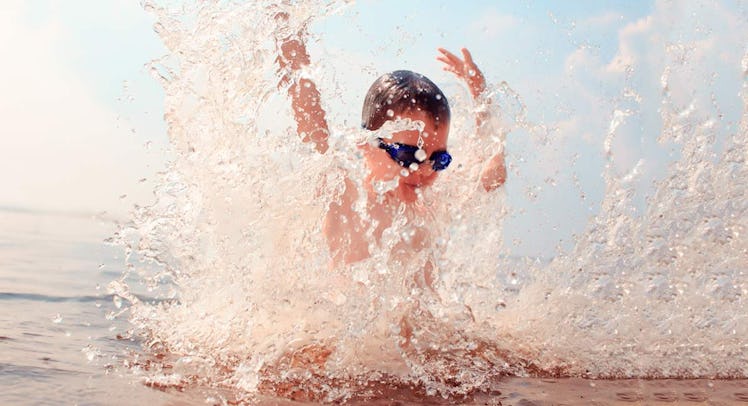An MIT Professor Explains How To Master The Splash This Summer
Rule the pool with some help from fluid dynamics.

If a kid jumps into a pool and there’s no one around to see it, does it make a splash? Of course it does. The splash is the reward of the jump. Kids wouldn’t be running around the pool, stepping back further and further to get and practicing that perfect jump if every entrance was met with a flaccid gulp. Pool jumpers everywhere live for the eruption of the water. That’s the thrill, man. And the cannonball is king for conjuring the best poolside splash.
Ever wonder why? Well, sometimes it takes an MIT professor to explain things that we all learn by the age of five, so John Bush, a professor of applied mathematics at MIT and a self-described fluid dynamicist, took time away from doing what were probably some important and intellectually productive things to explain why cannonballs are —and this feels like a technical term — so splashy as well as how to make the best one.
First, a lesson. There are four primary mechanical concepts interacting with one another whenever you watch someone jump in the pool: gravity, form drag, fluid inertia and, as far as cannonballs are concerned, the Worthington jet.
Form Drag: “When a large object moves through a fluid, you get a resistance, which is called a form drag,” Bush says. The change in densities through which an object is passing is highly relevant in this case, too, as the change of passing through the air into water creates impact.
Fluid Inertia: The body hitting the water is combating the resistance of the water, or its fluid inertia.“You basically get a pressure which resists your motion, which is proportional to your speed, squared, and the density of the water,” Bush says. This concept also plays a part in skipping stones and the ability of certain lizards to run across water.
Worthington Jet: When you drop a sphere into a liquid it creates a hole in the water, and the water that was pushed aside then rushes back to fill in that hole. “Basically, in hitting the surface, you’re displacing water,” Bush says. “You leave a cavity behind, and it’s the collapse of the cavity which causes the splash,” Bush says.
Think about Olympic high divers whose goal it is to create the smallest splash they can. The reason, in the terminology of fluid mechanics, that they so infamously try to enter the water as straight up and down as possible is to displace as little water as possible.
“Which is really an indicator of how much force you’re sustaining during impact,” Bush says.
Gravity: The farther you fall, the faster you are traveling when you hit the water (disregard here the concept of terminal velocity, which ideally isn’t going to be at play your local swimming pool).
“As you go higher you’re going faster so the impact is higher,” Bush says.
So, in summary: A cannonballing jumper accelerates through the air as they descend until they hit the placid water. They then lose force while plummeting below the surface; for fractions of a second a hollow space exists above them in the water, which the water naturally rushes in to fill, leading to a vertical splash – and for these purposes, ideally a large one.
So, Why Cannonballs?
Jump after jump, Bush says, your best bet to consistently displace the most water is the cannonball. Why? Physics, of course. The jumper will typically present the most exposed surface of area to the water while simultaneously maximizing the depth of descent into the water.
Of course, not all cannonballs are created equal. Little kids know this already — the bigger the jumper, the bigger the splash. Why? “The volume displaced is going to be proportional to your size,” says Bush. Which is why a cannonball executed by a scrawny 8-year-old will pale in comparison to a technically flawless dive by, say, a sumo wrestler — or just a husky 8-year-old.
What About a Belly Flop or Jackknife?
Advocates of the belly flop no doubt cry foul at all of the above. Their tortured bellies humbly protest that a flat impact is the splashiest of all options. They may be partially right, Bush says, because belly flops will create a larger horizontal spray than the cannonball. “Simply because you maximize the exposed [surface] area that way,” Bush says. But the belly flop’s vertical trajectory of splash will be much lower than the cannonball, Bush says, making it not ideal for winning splash competitions. “And, of course, it’s going to hurt like hell.”
While he maintains the cannonball is the most consistent jump to create the most splash, Bush allows that the jackknife offers an intriguing combination of depth and water displacement that combine the best parts of the cannonball and the belly flop, leading to both vertical and horizontal splash when done correctly.
“There you get sort of a wonky splash, it’s asymmetric,” Bush says. The one extended leg could create a deeper cavity than a cannonball. Add to that the often off-kilter, angle of the diver in a jackknife (leading to a heels-butt sequence of impact), and you’ve got some other equations in play. “Of course, if you go in sideways, there’s a sort of a lateral splash just from… your horizontal inertia deflecting fluid in a horizontal form.”
Could a properly executed jack knife create a larger splash than a cannonball? It’s a scientifically interesting question, Bush says, begging further investigation with high-speed photography, a swimming pool, and a willing test subject.
“That would be a fun thing to do,” he says.
This article was originally published on